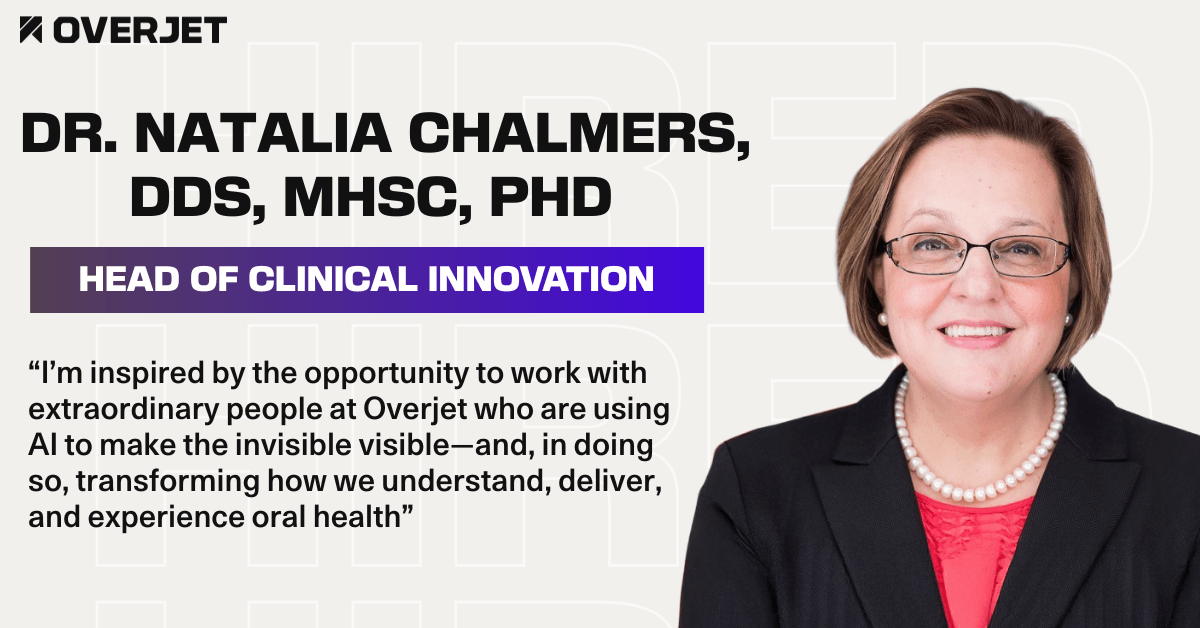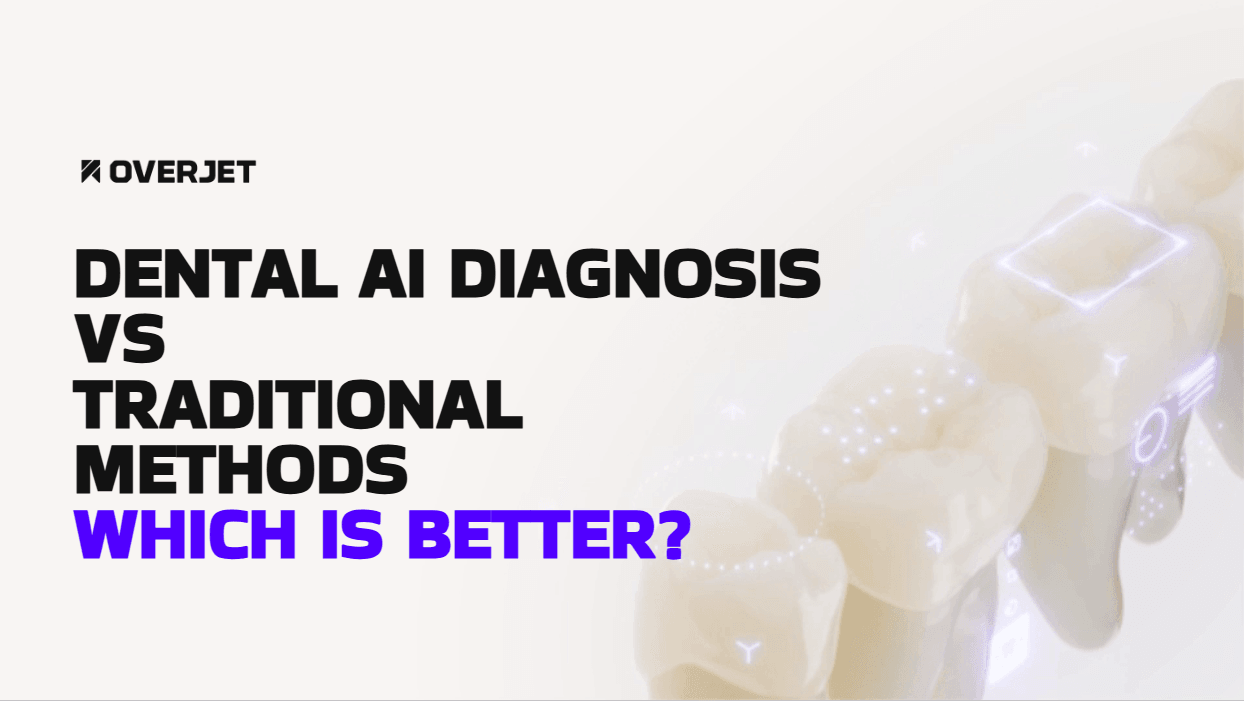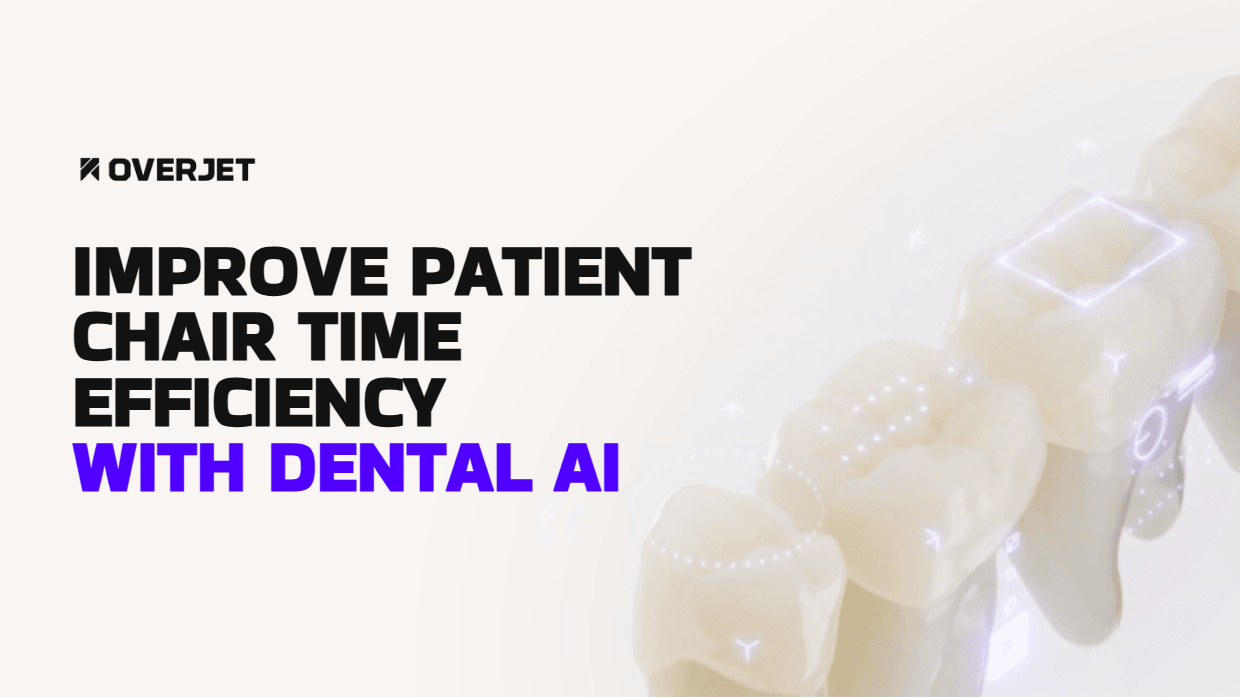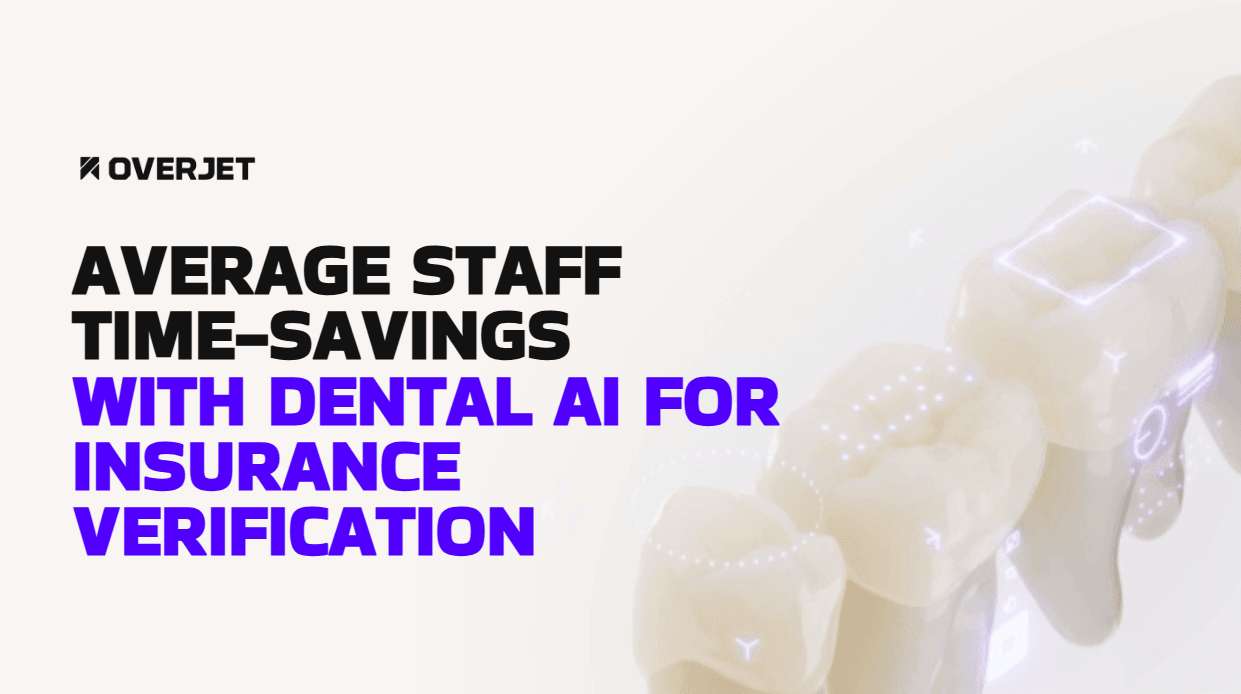Dental practices lose an average of 15 to 30 minutes per patient on manual insurance verification—time that could be spent on care delivery, patient education, or proactive treatment planning. When front desk teams spend their mornings on hold with payers or navigating outdated portals, patient flow suffers and revenue cycles slow.
Overjet’s Insurance Verification product provides automated verification of eligibility and benefits, streamlining dental practice operations.
Automated eligibility verification transforms this bottleneck into a seamless background process that happens in seconds rather than hours. This article explores how real-time verification improves patient intake efficiency, reduces claim denials, enhances patient communication, and integrates with clinical AI to streamline the entire care delivery workflow.
Explore Overjet's Dental AI Software
Importance of Accurate Dental Insurance Verification
Dental insurance verification confirms a patient’s coverage upfront, which reduces last-minute delays and billing errors during check-in. When practices verify eligibility, benefits, and limitations before appointments, they eliminate administrative bottlenecks that slow patient flow and frustrate front desk teams. Accurate verification delivers three core benefits:
Revenue protection: Confirming eligibility, annual maximums, and frequency limitations before treatment prevents unexpected claim rejections that erode practice profitability.
Patient trust: Providing precise out-of-pocket estimates at scheduling eliminates billing surprises that damage patient relationships and collection rates.
Workflow optimization: Reducing eligibility errors minimizes rework, phone calls to payers, and back-and-forth with patients.
Without verification, practices face denied claims, unhappy patients, and staff spending hours resolving preventable issues.
Time-Draining Challenges in Manual Intake Workflows
Traditional verification methods create friction at every stage of patient intake. Staff members spend significant portions of their day navigating payer portals, waiting on hold, and manually transcribing benefit details that may already be outdated by the time treatment begins.
Excessive Phone and Portal Hold Times
Front desk teams routinely spend 15 to 30 minutes per verification call, cycling through automated menus and waiting for payer representatives. When multiple patients arrive with complex plans or unfamiliar payers, hold times can consume entire mornings. Meanwhile, patients wait at the front desk and appointments run behind schedule.
Re-Keying Errors and Claim Rejections
Manual data entry introduces transcription mistakes that trigger claim denials weeks after treatment. A misread group number, transposed member ID, or incorrect dependent sequence can result in rejections that require staff to resubmit claims and delay payment by 30 to 60 days. Even small errors create additional work that perpetuates the verification backlog.
Inaccurate Cost Estimates at Check-In
Outdated benefit information leads to treatment estimates that don’t reflect actual coverage. Patients who were quoted one amount at scheduling receive bills for significantly higher balances after insurance processes claims. Even when staff verify benefits, plan changes or frequency limitations discovered mid-treatment force uncomfortable financial conversations.
Staff Burnout and Turnover
Repetitive verification tasks contribute to employee frustration and high turnover rates in dental practices. When talented team members spend hours on administrative busywork instead of meaningful patient interactions, job satisfaction declines.
Common manual verification pain points include:
Long payer portal wait times and phone queues
Conflicting information from different payer sources
Transcription errors from insurance cards
Late discovery of frequency limitations during treatment planning
Incomplete documentation for pre-authorizations
Repeated patient follow-ups that strain relationships
How Automated Eligibility Verification Works Step By Step
Automated systems connect directly to insurance databases and practice management software to eliminate manual verification tasks.
1. Real-Time Benefit Information from Integrated Portals, EOB Systems, and Third-Party APIs
Software connects to insurance databases through real-time benefit information from integrated portals, EOB systems, and third-party APIs, returning eligibility status, plan details, frequency limitations, and remaining maximums in seconds. This direct connection bypasses phone queues and provides current information that reflects recent plan changes or benefit updates. Overjet’s verification platform queries payers in real time, ensuring practices work with the most accurate data available.
2. AI OCR Card Capture
Optical character recognition technology extracts member IDs, group numbers, and payer details from insurance card images automatically. Advanced systems normalize formatting variations across payers and flag inconsistencies between card data and payer responses. This automation reduces transcription errors while maintaining accuracy through AI-powered validation.
3. Automatic Benefit Mapping to CDT Codes
Systems match dental procedure codes to specific coverage levels, frequencies, age restrictions, waiting periods, deductibles, and alternate benefits. This mapping translates raw eligibility data into actionable treatment planning information. Overjet’s AI cross-validates payer responses against proposed treatment codes, highlighting potential conflicts before claims are submitted.
4. Push to PMS and Patient Forms
Verified benefits, fee schedules, and estimates sync directly to patient records and intake forms within practice management systems. This integration eliminates re-keying and ensures consistency across platforms. Automated form population accelerates check-in while reducing the risk of data entry mistakes.
Key Performance Gains From Real-Time Verification
Practices that implement automated verification experience measurable improvements across operational metrics. Pre-verified benefits shorten arrival-to-rooming time by eliminating last-minute eligibility checks, allowing practices to maintain schedule flow even during high-volume periods. Advance verification prevents treatment delays and awkward financial conversations that occur when coverage issues surface mid-appointment.
Overjet’s AI enables faster insurance verification, improving workflow efficiency and reducing administrative burdens.
Metric | Manual Verification | Automated Verification |
Average verification time per patient | 15–30 minutes | 30–90 seconds |
Same-day coverage surprises | 15–20% of appointments | <5% of appointments |
Front desk capacity for patient engagement | 40–50% | 70–80% |
Real-time verification delivers specific performance benefits:
Lower claim denial rate: Accurate eligibility and benefit mapping reduce denials related to eligibility and frequency violations.
Higher collections per visit: Clear out-of-pocket estimates enable point-of-service collections and reduce the need for multiple patient statements.
Front desk capacity reallocation: Staff can shift from verification calls to patient-facing tasks like appointment coordination and proactive recall scheduling.
Impact on Patient Communication and Case Acceptance
Verification improvements directly enhance patient experience and treatment acceptance rates. When practices combine accurate benefit information with clinical evidence, patients make informed decisions with confidence.
Transparent Out-Of-Pocket Estimates
Accurate benefit information enables clear financial discussions upfront, with deductibles, co-insurance, and remaining maximums reflected in real time. Treatment coordinators can present precise cost breakdowns during case presentations rather than offering vague ranges. This transparency builds trust and reduces the anxiety patients feel around dental expenses.
Trust-Building Visual Aids and AI Imagery
Verified coverage combined with clinical AI creates compelling case presentations that visually align findings with covered treatment. When practices show patients annotated radiographs highlighting conditions alongside benefit breakdowns for recommended procedures, acceptance rates increase significantly. Overjet’s [AI imaging platform detects oral diseases with FDA-cleared precision and generates clear visual evidence that supports both clinical necessity and insurance justification.
Faster Scheduling of Recommended Treatment
Pre-authorization and benefit verification accelerate treatment planning by removing administrative barriers between diagnosis and care delivery. Patients who understand their coverage and financial responsibility at the time of case presentation schedule treatment immediately rather than deferring decisions. When paired with Overjet’s AI imaging and clinical insights, teams can show patients visual evidence alongside precise coverage details.
Implementation Checklist for Dental Practices
Practices considering automated verification systems benefit from a structured implementation approach. Following a step-by-step process minimizes disruption while maximizing adoption and results.
Select metrics and baseline: Define KPIs such as check-in time, denial rate, rework rate, and collections per visit; capture a 30–60 day baseline to measure improvement.
Map current intake workflow: Diagram touchpoints from appointment scheduling to claim submission to identify bottlenecks and handoffs.
Choose integration approach: Confirm compatibility with your practice management system and clearinghouse.
Configure payer rules: Set up payer lists, plan rules, CDT mappings, and pre-authorization triggers.
Train team on new procedures: Educate front desk staff, treatment coordinators, and billers on new workflows and exception handling.
Pilot and validate: Run parallel verification for two to four weeks, comparing automated results against manual checks.
Go live and monitor: Roll out broadly while using dashboards to track KPIs and system performance in real time.
Iterate and optimize: Adjust templates, scripts, and automations based on real-world results and staff feedback.
Implementation timelines may vary; contact Overjet for details on onboarding and setup.
Integrating Verification Data With Clinical AI Insights
Advanced practices are connecting insurance verification with AI diagnostic capabilities to create comprehensive patient care workflows. This integration represents the next evolution in dental practice efficiency.
Linking Eligibility to Radiographic Findings
AI-detected conditions can be matched with verified coverage for treatment planning, prioritizing benefits that maximize patient outcomes while minimizing out-of-pocket costs. When systems automatically flag conditions that align with available benefits, treatment coordinators can build financially optimized care plans. Overjet’s platform unifies FDA-cleared diagnostic AI with benefit intelligence, enabling this level of precision.
Auto-Generating Evidence-Based Treatment Plans
Clinical AI and benefit verification create comprehensive care proposals that pair findings with covered CDT codes, fee estimates, and scheduling readiness. Rather than manually cross-referencing radiographic findings with benefit details, systems generate complete treatment plans that include clinical rationale, visual evidence, coverage percentages, and patient responsibility.
Syncing Narrative and Attachment Requirements
Systems coordinate clinical documentation with insurance submission requirements, auto-including narratives, radiographs, and intraoral images to meet payer-specific rules. Different payers require different documentation for pre-authorization and claim adjudication. Automated systems apply payer rules consistently, reducing the manual effort required to compile submission packets.
The Road Ahead for AI-Driven Intake Efficiency
The future of patient intake lies in deeper payer interoperability, predictive pre-authorization, and automated narrative generation. Emerging technologies will enable end-to-end touchless intake where patients provide minimal information and systems handle verification, documentation, and financial counseling automatically. Machine learning models will predict which treatments require pre-authorization based on historical payer behavior.
Overjet continues to lead in dental AI innovation, expanding capabilities that connect clinical insights with administrative efficiency. See how automated verification and AI diagnostics transform your practice.
Ready to See Overjet's Dental AI in Action?
Frequently Asked Questions (FAQs)
How long does it take to deploy an automated verification system?
Most practices can implement automated eligibility verification within two to four weeks, including staff training and system integration with existing practice management software. Complexity varies based on payer mix, patient volume, and the number of locations being connected.
Is automated eligibility verification HIPAA compliant?
Yes, reputable verification systems maintain full HIPAA compliance through encrypted data transmission, secure storage protocols, and regular security audits that meet healthcare privacy standards. Practices can verify compliance certifications during vendor selection.
Will the software work with my existing clearinghouse and PMS?
Modern verification platforms integrate with most major practice management systems and clearinghouses through standardized APIs and data exchange protocols. Compatibility can be confirmed during the evaluation process, as some legacy systems may require custom integration work.
How does automation handle specialty procedures and orthodontics?
Advanced systems can verify coverage for complex treatments by analyzing specific CDT codes, annual maximums, lifetime limits, and specialty benefit structures automatically. Orthodontic verification includes treatment duration, age restrictions, and payment timing to ensure accurate estimates for multi-visit care plans.









